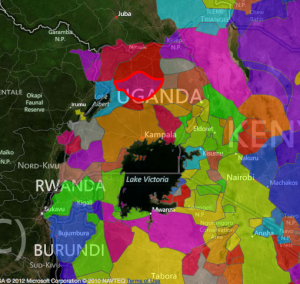In our next field visit to Northern Uganda we will come across a mix of different tribes, including the Lango peoples.
Location: Northern central region or the “Lango sub-region” as demonstrated on the map.
Population: about 1.5 million people
Language: They speak Leb-Lango, a language similar to those of the Acholi and the Alur. They are part of the Luo group or “Western Nilotic Group”, and so all of the languages in this area are fairly similar to understand.
Origins: Their original homeland was north of Lake Turkana where they used to live along with the Jie and the Karimojong. This means, by implication, that the Langi are also related to Dodoth, Lotuko, Topsa, and Turkana of Kenya. Together with the Iteso, Kumam and Karimojong, they comprise the Atekerin family in Uganda.
Customs: The Lango have a cultural distaste for witchcraft, and a strong work ethic. They live in small groups, and recognise no tribal chief, except those chosen to defend the common interest in the time of war. Hutchinson in “The Living Races of Manki nd” adds, ‘The Lango are specially noted for the care bestowed on their elaborate and highly fantastic head-dress. The prevailing fashion may be described as a kind of a helmet. ..Lango women, who are amongst the finest and most symmetrical of the Equatorial lake regions, wear little clothing or embellishments beyond west-bands, necklaces, armlets, and anklets.’ (p. 360). The Lango symbol is Amuka (Rhino). Amuka is independent, strong, and peaceful unless disturbed.
nd” adds, ‘The Lango are specially noted for the care bestowed on their elaborate and highly fantastic head-dress. The prevailing fashion may be described as a kind of a helmet. ..Lango women, who are amongst the finest and most symmetrical of the Equatorial lake regions, wear little clothing or embellishments beyond west-bands, necklaces, armlets, and anklets.’ (p. 360). The Lango symbol is Amuka (Rhino). Amuka is independent, strong, and peaceful unless disturbed.
References
Curley, Richard T. (1973). Elders, Shades, and Women: Ceremonial Change in Longo, Uganda. Berkeley and Los Angeles: University of California Press.
Otiso, Kefa M. (2006). Culture and Customs of Uganda. Ohio: Greenwood Press.

